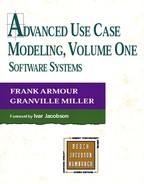Part 4. Advanced Use Case Modeling Framework: Expanding the Use Case Model
What’s in this part?
This part discusses how initial use case descriptions are expanded with more detail and how the increased complexity is modeled.
As described in the last chapter, the outcome of the initial use case modeling activities is a conceptual picture of the role the system will play in the organization. The conceptual use case model describes the system’s major responsibilities and the specific actors (people, other systems, and so on) that the system interacts with. The objective of the conceptual analysis is not to focus on the details of these system requirements but to capture an overall understanding of the system’s place in its environment.
So far, the major actors and the use cases they participate in have been identified for the system. The use cases and the business event that triggered them have been documented with short descriptions. Key business objects that are within the scope of the system’s responsibilities have been identified.
Conceptually, the overall scope and boundaries of the system are starting to become clear. Key decision makers and users have had an opportunity to review and validate the conceptual use case model and provide input. The specifics of each use case, however, are still unclear and ambiguous. For the purpose of discovering and modeling more specific system requirements, we further refine our understanding of what takes place within each use case.
Since a use case describes the set of transactions that occur based on a business event and provides measurable value to an actor, a single use case can contain multiple requirements. A use case is a story, and the story can involve many specific interactions and system behaviors. Each of these interactions and behaviors needs to be identified, alternatives need to be discovered, and behaviors that are common across multiple use case must be modeled. Following are the activities in the “Expand on the use case model” activity group (Figure P4-1).
• Develop base use case descriptions
• Elaborate the use case’s flow of events and other related information
• Model extend, include, and generalization relationships
• Map use cases to object models and other analysis models
• Develop instance scenarios
Figure P4-1. Expanding use case modeling activities

This activity group is the heart of advanced use case modeling for software systems. Even though the activities in this group are discussed in a specific order, in our experience a tremendous amount of iteration occurs among them. Because these activities are the heart of the use case modeling process framework, each activity is discussed in its own chapter, from Chapter 8 through Chapter 14.
